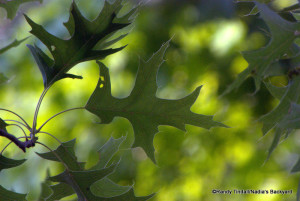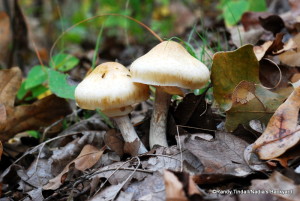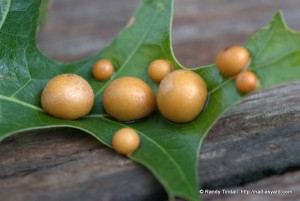Our backyard is inexhaustible.
No, I don’t mean that it never gets tired, although that may be true, but that it is so much more than a plot of land enclosed by a battered fence out behind our house, as if that flimsy barrier of wood and mesh somehow isolates it from the greater world. I see that fence every day, but when I start pondering I see no barrier, no boundary, except for the legalistic purposes of our society. That fence mainly says, “This is ours, not yours. You need permission to come in here.” (Well, it also keeps our dog in, but that’s another tale….)
We humans generally like things in neat packages, seems to me, easily categorizable into manageable units we can comprehend. This yard, that tree, yonder bug. Or Nadia and me, individual people designated by names and personae that make us accessible to others. But what are we, really?
Our yard is just another node in a vast nexus of unceasing activity and transaction, and nothing asks permission—birds fly in and out, soil creatures migrate unhindered beneath and through our fence, insects swarm everywhere, plants come and go. Sometimes, the more I try to define our yard, or anything in it for that matter, as a distinct, identifiable entity, the weirder things get.
I can’t even define me.
Now, I don’t mean that in some spiritual sense of a mystical oneness with the ALL, whatever name you may choose to give it. I mean it in a strict biological sense. One real eye-opener of the last few years has been research into the human biota, the nearly unexplored and unexpectedly vast compilation of organisms that live in us. Or perhaps I should change the last part of that sentence to “are us”. There may be up to 100 trillion (with a “T”) organisms in our gut flora alone, ten times the number of cells in our bodies proper. These organisms mediate many things, from digestive activities to immune responses and have been described as a “forgotten organ”
This doesn’t include the potentially trillions more organisms living elsewhere on and in us, fulfilling roles that we haven’t even begun to research, yet. It is thought that mitochondria, those little engines that provide energy to cells and muscles, may be the remnants of microorganisms that became so symbiotic with their hosts that they eventually lost their separate identities and became instead cellular organelles within multicellular creatures. All of this has led one researcher, Dr. David Relman, a Stanford microbiologist, to compare humans to coral, “an assemblage of life-forms living together.” It may be, he says, that we are little more than packaging for the microbes that make up the largest part of us! We are like a backyard fenced in by skin, a package just as arbitrary as the backyard I see outside the window, communicating with the greater world, changing, evolving, exchanging visitors, dynamic.
So what? I’m still me, right? Well, maybe, whatever that actually means. Consider that some microorganisms are known to influence mammalian behavior. One, Toxoplasmosis gondii, reproduces in cats. When it infects mice or rats it alters their behavior by making them less afraid of cats and, therefore, more likely to become cat food. In other words, it seems to use rodents to get to the nursery to make more parasites! So the next question is, how many of the potentially thousands of species of microbes making up the human biome may have a direct effect on our behavior and perceptions? How much of our vaunted intelligence, culture and free will may be subverted to further microbial reproduction, rather than, or as much as, our own?
We don’t know.
In our backyard, whatever I am looks at whatever it is and sees trees, animals, insects and many other things. That’s what the eyes of my body see. My mind’s eye, more and more, sees forms that come and go, changing constantly, and which do not necessarily represent individuals. The stately pin oak that sheds huge quantities of leaves and little acorns in one corner of our yard is certainly not restrained by the flimsy boards of our privacy fence.
Its roots extend far beyond into the neighbor’s property and they in turn are probably in intimate communication with most everything else growing nearby via a fungal internet made up of mycorrhizal filaments. These fine, hairlike structures originate in fungi and are virtually everywhere in the soil, connecting most plants via their roots and sometimes penetrating even the plants’ cells. This network does many things, such as aiding in nutrient and water uptake, but, like the cat-loving parasite above, it seems to do a lot more. It can also influence plant behavior in some surprising ways. For example, it has been shown to serve as an early-warning system for insect attack and disease in some plants. Plants experiencing attack by aphids, for example, can send signals via mycorrhizae to neighboring uninfected plants telling them to “Get ready!” Plants that receive these signals secrete chemicals that discourage aphids, but encourage parasitic wasps that prey on aphids. Other plants isolated from the fungal network do not. Guess who makes out better when the attack hits?
I expect our pin oak probably chats with our token poison ivy plant in another corner of the yard and with the wafer ash next to it, maybe through the mushrooms which live underground and pop up now and then to form caps.
I have no clue what they might be discussing, but it does make me wonder how much one can define organisms that are physically intertwined at an intimate level as “separate” organisms. Consider that this network is probably of vast extent, extending over long distances, and it may be that our oak even gets occasional messages from beyond the horizon.
That oak tree and everything else in our yard also has its own biome, like me. From hundreds of thousands of leaf galls inhabited by wasps and midges, to the trillions of microorganisms that surely inhabit it.
Who is to say whether what I see as a tree is the real oak or if the oak is actually the sum total of that dynamic assemblage of life? Is it even possible that the oak and I communicate on a level that I simply can’t detect? Do we speak, down deep where the world murmurs beneath our hearing and sight?
This is hardly a new theme. As I wrote this my memory flashed back to a book I read decades ago and had nearly forgotten about. The Lives of a Cell, by Lewis Thomas, discusses some of these same ideas, but I hardly hear the book mentioned these days. Too bad, because the ideas are as fresh now as they were in 1974. They are more real to me now than they were then, two years out of high school and bumbling quite clumsily through life.
I think I’ll reread Thomas this summer. Outside, in our backyard.
Once in a while I will close my eyes and hold my breath.
I will listen very hard.





